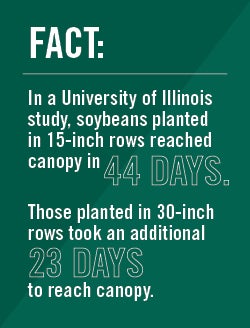The pressure to effectively manage weeds is at an all-time high for soybean growers.
Today, many growers find themselves fighting herbicide-resistant weeds, facing the threat of a resistant population with the potential for spread. This requires growers to consider approaches and practices that tap into proven herbicide chemistries, such as Group 14 and 15 active ingredients – sulfentrazone and pyroxasulfone – while complementing or even enhancing their efficacy. But what kinds of tactics fit this bill?
“Simply put, we need to diversify our weed management system. Cultural, biological and mechanical practices are some important keys that can help us,” says Nick Hustedde, technical service manager for FMC. “Coming at a weed like waterhemp with a multifaceted approach is what it may take to win that battle.”
KNOWING YOUR OPTIONS
When digging through the toolbox, there are a host of practices to leverage that can complement a herbicide program. To Bill Johnson, professor of weed science at Purdue University, the best way to address the planning process is to look at each biological, cultural or mechanical practice on an individual basis.
“It’s important, especially heading into a season like 2022, to think critically about the practices,” Johnson says. “For example, tillage. Growers need to think about a practice like this on a field-by-field basis and decide which fields are the best candidates.”
Implementing tillage at preplant can remove any weeds that have already started to germinate and expose weed seeds buried beneath the surface. In this situation, Johnson says applying a preemergent herbicide with a strong residual can help provide successful weed control.

"An approach like this ensures a grower is getting distribution with that herbicide application and contact with the weed seed,” Johnson says.
Another popular cultural practice is narrower, 15-inch soybean row spacing. This option creates canopy closure as fast as possible. This reduces weed competition, late-season germination and weed seed production. But it also complements a grower’s herbicide program.
In a University of Illinois study, soybeans planted in 15-inch rows reached canopy in 44 days. Those planted in 30-inch rows took an additional 23 days to reach canopy.
“What this tells me is that we need 23 more days of herbicide residual to get to canopy. As we widen our rows, we place more pressure on the herbicides. Narrow row spacing provides some alleviation,” Hustedde says. “Once canopy closure happens, Mother Nature takes over and that reduces the chances of in-season weed escapes.”
MAKING SURE IT’S A FIT
Though herbicides and overall weed control can benefit from the use of biological, cultural and mechanical practices, these tactics might not always be a fit for every acre. Johnson points out that to create successful results, it all starts with how well you know the weeds populating your fields.
“Typically, in smaller sized farm, the operator knows their weeds on a more intimate level. They can make these practices work better. On larger acre operations, it can be more of a struggle for operators to have an intimate knowledge of what’s going on in the field,” Johnson says.“But whatever your situation, take the most problematic fields first and start to experiment with some different practices. If you have success and see benefits, build from there.”
From Hustedde’s perspective, whatever direction a grower chooses to go, it’s about complementing their herbicide program.
At the end of the day, we want to use the most effective active ingredients and pair them with something that takes the pressure off the herbicide early in the season to help us get zero escapes and minimize the seed return,"
“At the end of the day, we want to use the most effective active ingredients and pair them with something that takes the pressure off the herbicide early in the season to help us get zero escapes and minimize the seed return,” Hustedde says. “If we do this and fight off the weed populations and weed seedbank, we’ll see the returns in the bin.”
Always read and follow all label directions, precautions and restrictions for use. Some products may not be registered for sale or use in all states. FMC and the FMC logo are trademarks of FMC Corporation or an affiliate. ©2021 FMC Corporation. All rights reserved. 21-FMC-3221 12/21



